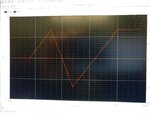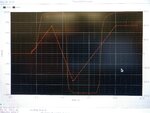mr_mosfet
Newbie level 3
Hello,
Hopefully this is posted in the right area. I'm trying to model the current of the device which is captured by one of the last lines of this code:
(I(p,n) <+ ddt(polar)
When I implement the code as above I get a flat line for the current (brown curve in the first pic named "ddt_polar"). However I think it should be nonzero in places. I ran the same simulation with the current set to:
I(p,n) <+ polar;
and got the curve as seen in the second pic named "polar". Clearly the polar variable is changing so ddt(polar) should give me a nonzero current but its not. Why is this so?
Thank you.
Hopefully this is posted in the right area. I'm trying to model the current of the device which is captured by one of the last lines of this code:
(I(p,n) <+ ddt(polar)
Code:
// VerilogA for tech_support3, test, veriloga
`include "constants.vams"
`include "disciplines.vams"
`define M_PI 3.14159
module test(p,n);
inout p,n;
electrical p,n;
real v_prev;
real v_present;
real v_c_pos;//positive coercive voltage
real v_c_neg;//negative coercive voltage
real v_tp_pos;//positive turning point
real v_tp_neg;//negative turning point
real polar;
real polar_r;
real polar_tp_pos;
real polar_tp_neg;
real polar_temp;
analog function real f;
real v; real v_c;//v_c is coercive voltagle
input v; input v_c;
f = (2/`M_PI)*atan((v-v_c));
endfunction
analog begin
@(initial_step) begin
v_prev = 0;
v_present = 0;
v_c_pos = 5;
v_c_neg = -5;
v_tp_pos = 5;
v_tp_neg = -5;
polar = 0;
polar_r = 1;
polar_tp_pos = 0;//positive coercive voltage
polar_tp_neg = 0;//negative coercive voltage absolute value
end
if ((v_present > v_prev) && (v_present > 0)) begin
polar_temp = polar_tp_neg + 0.5*polar_r*(1 + f(v_present, v_c_pos))*(1 + f(-1*v_tp_neg, -1*v_c_neg));
if(polar_temp > polar)
polar = polar_temp;
if (v_present > v_tp_pos)
v_tp_pos = v_present;
polar_tp_pos = polar_tp_neg + 0.5*polar_r*(1 + f(v_present, v_c_pos))*(1 + f(-1*v_tp_neg, -1*v_c_neg));
end
if ((v_present < v_prev) && (v_present < 0)) begin
polar_temp = polar_tp_pos - 0.5*polar_r*(1 + f(v_tp_pos, v_c_pos))*(1 + f(-1*v_present, -1*v_c_neg));
if(polar_temp < polar)
polar = polar_temp;
if (v_present < v_tp_neg)
v_tp_neg = v_present;
polar_tp_neg = polar_tp_pos - 0.5*polar_r*(1+ f(v_tp_pos, v_c_pos))*(1 + f(-1*v_present, -1*v_c_neg));
end
v_prev = v_present;
v_present = V(p,n);
I(p,n) <+ ddt(polar);//current equation currently not working
end
endmoduleWhen I implement the code as above I get a flat line for the current (brown curve in the first pic named "ddt_polar"). However I think it should be nonzero in places. I ran the same simulation with the current set to:
I(p,n) <+ polar;
and got the curve as seen in the second pic named "polar". Clearly the polar variable is changing so ddt(polar) should give me a nonzero current but its not. Why is this so?
Thank you.

